Introduction
The extraordinary and surprising increase in the creation and ownership of employer businesses since 2020 has been concentrated among certain demographic groups. Figure 1 shows, relative to the fourth quarter of 2019, the change in “high-propensity” business applications, which are applications of the type that have historically resulted in businesses with employees (United States (U.S.) Census Bureau 2024a; Haltiwanger 2021). Recent research suggests that, indeed, this historical relationship is still apt, and thus that these “high-propensity” applications portend an unprecedented pace of employer business formation (Decker and Haltiwanger 2022; Decker and Haltiwanger 2023).
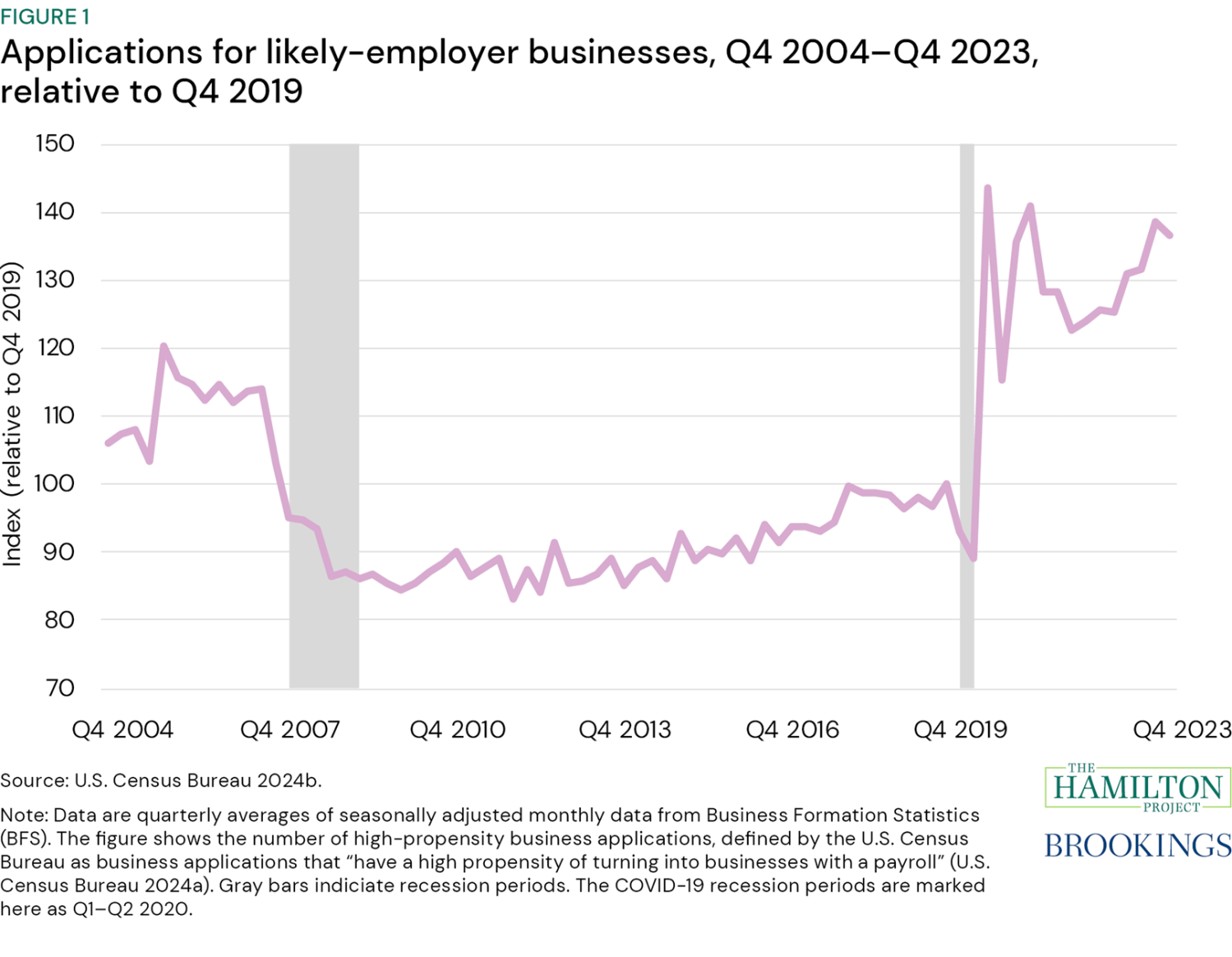
In this piece, we use the Survey of Consumer Finances (SCF) to better understand how trends in employer business ownership have changed in recent years for different groups. In general, as we show below, business ownership is more common among white individuals, those with higher levels of educational attainment, and those with higher incomes. However, between 2019 and 2022, gaps in business ownership shrunk between groups. In this period, the share of Black and Hispanic families with ownership in employer businesses rose, while white families did not report a similar increase.
Those changes reflect significant differences in which families gained business ownership from 2017 to 2019 and which gained ownership from 2020 to 2022, when the COVID-19 pandemic and the policy response reshaped much of the economy. Black and Hispanic families had large gains in business ownership over the past three years relative to the previous three-year period.
The overall increase in business formation has proved more durable than we or other observers expected. Of course, we cannot yet know what the long-run impact of this increase is or how the demographics of business ownership will look in the years ahead. It will be important to keep watching what happens to these businesses as well as ownership rates for groups who have recently experienced large increases in ownership. This is especially crucial given research showing that young businesses generally have high failure rates but that a small share of young businesses experience very high levels of growth and job creation (Haltiwanger, Jarmin, and Miranda 2013; Decker et al. 2014).
Moreover, we leave to other researchers the analysis of which developments have improved access to business ownership across demographic groups. For example, fiscal support in 2020 and 2021 may have helped to finance business creation among credit constrained groups. But, the acceleration in overall business creation continued into 2023, long after fiscal support ended.
We conclude with several ideas for policymakers to extend the recent positive developments in business formation, in a way that would help to close wealth gaps and make the economy more resilient and dynamic.
Related work
Previous research has carefully documented the overall increase in business applications since 2020. We extend this research by delving deeper into the demographic distribution of the increase in business ownership. Most of the research documenting the recent increase has used the U.S. Census Bureau’s Business Formation Statistics (BFS; see, for example, Haltiwanger 2021). In addition to the BFS, there is also available data on establishment births and deaths from the Bureau of Labor Statistics’ (BLS) Business Employment Dynamics (BED) data. However, neither the BFS nor the BED provide publicly available data on demographics such as race and ethnicity, income, and educational attainment, all of which we analyze in this piece.
There have been several pieces recently attempting to look at the demographics of who is applying for and starting businesses in the U.S. Using cross-sectional data, Dinlersoz et al. 2023 find that areas with a higher proportion of Black individuals had a higher propensity for business applications but lower startup rates per capita. Fazio et al. 2021 find that, between 2019 and 2020, areas with a higher share of Black residents, particularly higher-income areas, are associated with higher growth in startup formation rates. They find that areas with a 10-percentage point higher share of Black residents saw a 3.2 percent higher increase in business formation.
Our methodology
To explore the change in the demographic distribution of business ownership since 2020, we use the SCF, a triennial cross-sectional survey of U.S. families. Importantly, we do not use the SCF to estimate the number of employer businesses in the U.S. Rather, we attempt to understand trends in ownership of employer businesses by various demographic groups: race and ethnicity, educational attainment, and income quantile. The SCF is commonly used to understand changes in wealth across demographic groups (Aladangady et al. 2023, Perry et al. 2024). It is also a particularly useful dataset in understanding pandemic-era changes in business ownership and net worth—the 2022 SCF provides more timely information about how business ownership changed in the past few years than other sources with the same type of demographic information. However, it is worth emphasizing that more than one family can jointly own a business and that a given family could own more than one business.
In this piece, we define ownership in an employer business as ownership in an actively managed business with more than one employee (total of 9 million respondents in the 2016 SCF, 10 million in the 2019 SCF, and 11 million in the 2022 SCF). We find similar trends when we further limit the employment condition to exclude ownership in businesses where the only employees are the respondent and the respondent’s spouse (i.e., only including businesses where there is at least one employee who is not either the respondent or the spouse). This condition results in a total of 8 million respondents in the 2016 and 2019 SCF and 9 million in the 2022 SCF. Additionally, we find similar trends when we limit the ownership stake to 50 percent or more.
We examine both business ownership overall (i.e., ownership gained at any point) and business ownership among families who gained ownership over the three years prior to and including each survey year. Doing this, particularly for the 2022 SCF, helps to focus on the post-COVID period and ensure that recent changes in the distribution of ownership are not simply due to certain older businesses failing. We look both at what share of families own businesses as well as at the value of their business ownership. We also look at how that ownership contributed to overall net worth and changes in net worth for different families.
What share of business owners do different demographics groups comprise?
We first look at the composition of business owners by various demographic factors: race and ethnicity, educational attainment, and income quantile. Figure 2 shows the composition of owners of employer businesses by race and ethnicity. White, non-Hispanic (“white”) families make up the lion’s share of business ownership in the U.S. In 2019, 80 percent of business-owning families were white, compared to 5 percent Black, non-Hispanic (“Black”) and 4 percent Hispanic or Latino. In the 2022 SCF, these gaps began to shrink—73 percent of business owners were white, 8 percent were Black, and 7 percent were Hispanic or Latino. The Annual Business Survey (ABS), which tracks employer businesses through 2021, similarly shows a substantial increase in recent years in the number of businesses with Black owners who have at least a 50 percent ownership share. However, the share of businesses in the ABS with Black owners is lower overall than in the SCF, perhaps reflecting, in part, that Black business owners more often own a smaller share of businesses (ABS 2019—21).
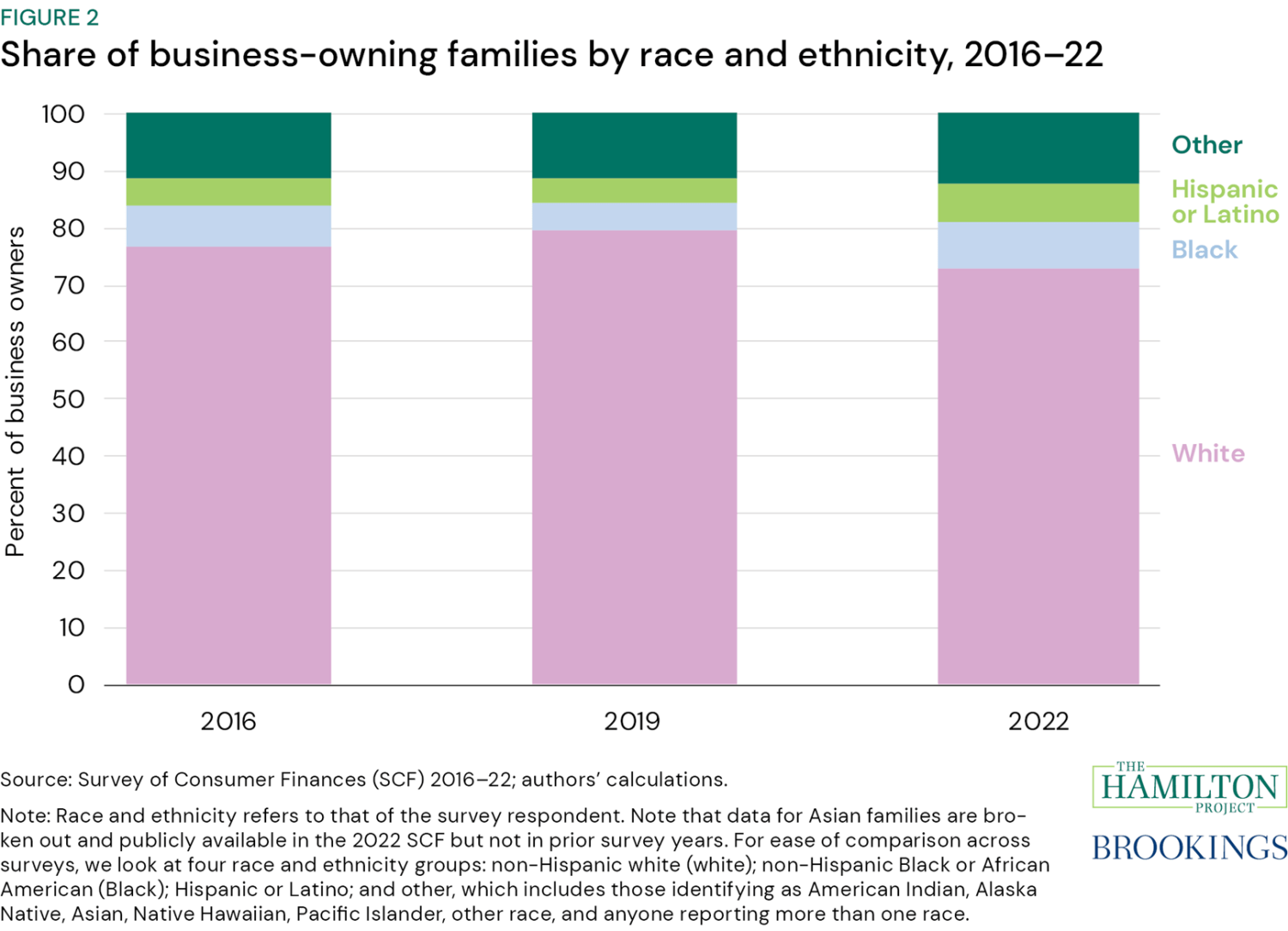
Figure 3 shows the same analysis for families who gained ownership in the three years prior to and including each survey year. (For example, in the 2022 SCF, this includes all families who gained ownership over a business anytime in 2020 through 2022.) We find that in the 2016 and 2019 surveys, 2 million families gained ownership in the recent three-year period, while that figure was close to 3 million in the 2022 SCF, meaning that, in aggregate, more families gained ownership over a business in the past three years (2020–22) than in the prior two three-year periods (2014–16 or 2017–19). Because limiting to ownership gained in the prior three years produces a much smaller sample of families, there is less precision in these estimates than those for all businesses.
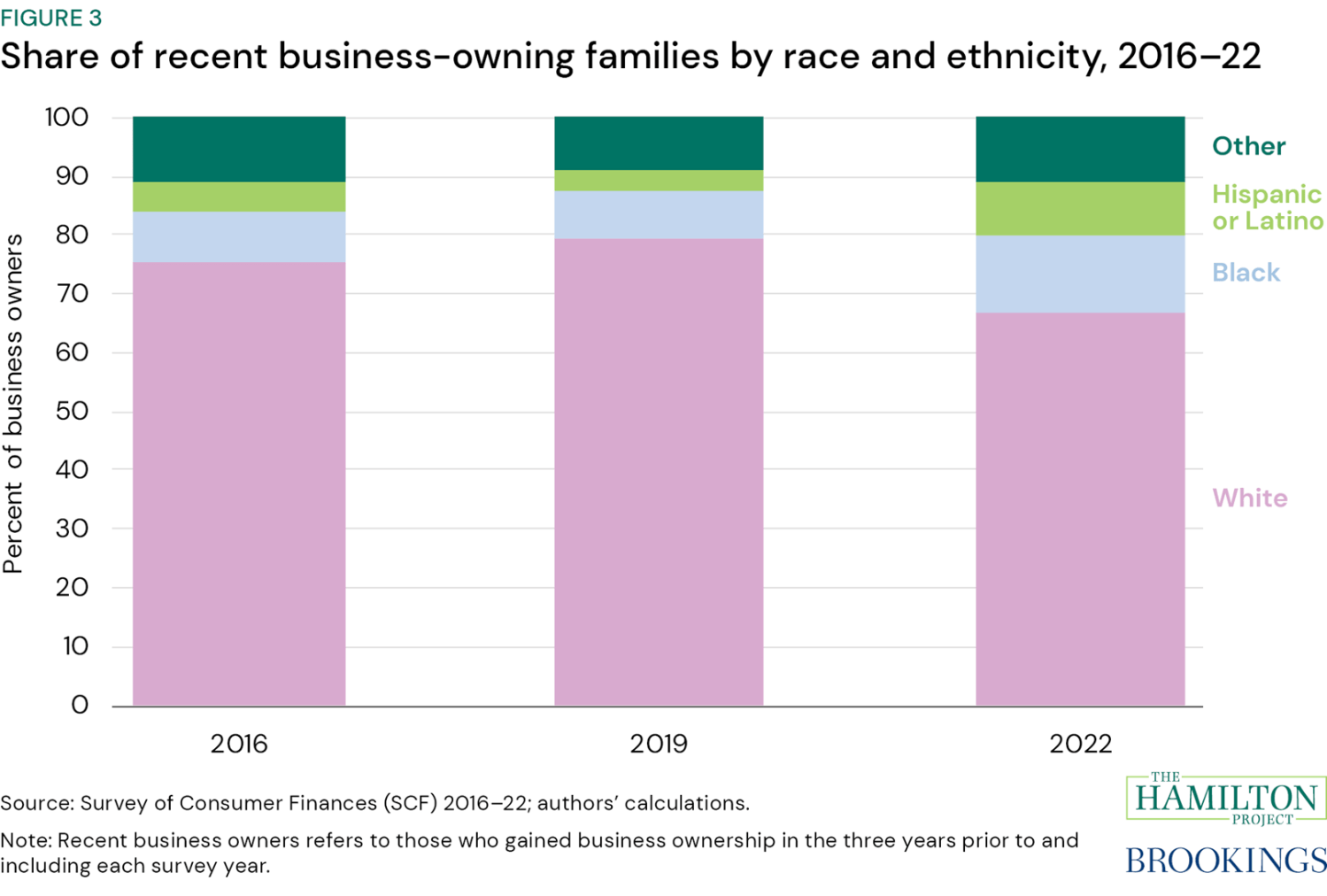
For Black (blue portion of the bars) and Hispanic or Latino (light green portion of the bars) families, the increases in recent business ownership are even starker than increases in overall ownership. In 2022, 13 percent of families who gained business equity in the past three years were Black and 9 percent were Hispanic or Latino, compared to 8 percent and 4 percent, respectively, in the three years prior to and including 2019.
For ease of interpretation, figure 4 shows the information in figures 2 and 3 for just Black families. In 2022, the share of Black families with business ownership gained in the past three years (dark blue) rose dramatically compared to the change in overall business ownership (light blue).
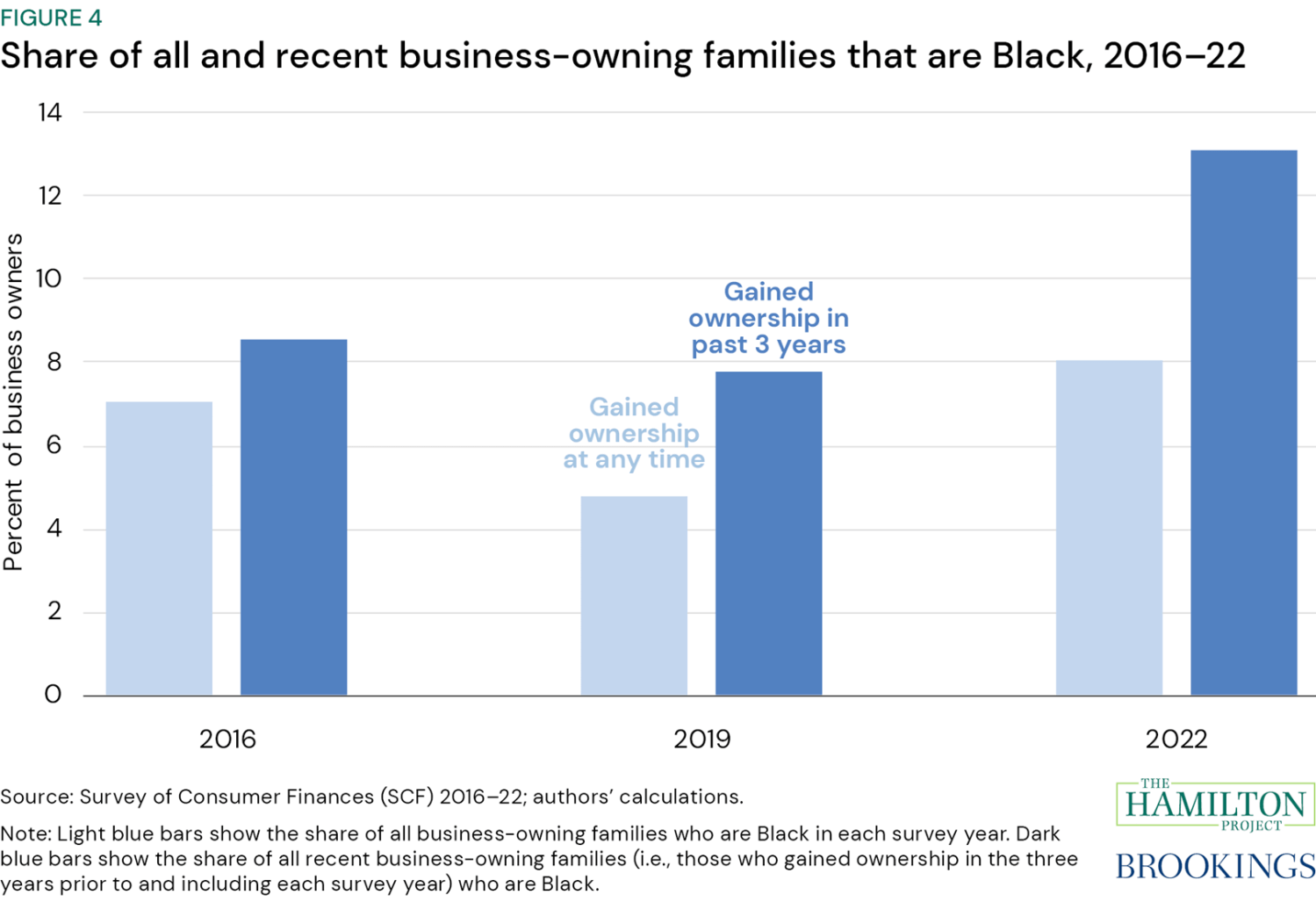
What share of each group owns businesses?
In the past several years, the share of the U.S. population that owns a business has increased, and we examine the demographic distribution of those changes. As a useful benchmark, in 2016, 13.0 percent of families owned any kind of business equity. That share ticked up to 13.4 percent in 2019 and then jumped to 14.6 percent in 2022. Limiting to employer businesses where the owner had an active role, we find that 7.3 percent of families owned businesses in 2016, 7.5 percent in 2019, and 8.1 percent in 2022.
As figure 5 shows, those with higher levels of educational attainment (panel A), white families (panel B), and those with higher income (panel C) were consistently more likely to own businesses from 2016 (light green) through 2022 (blue). For example, the gap between the income quantiles is large: Across years, a much smaller share of families in the lowest and middle-income quantiles owned equity in employer businesses relative to families in the top quantile. Likewise, a much greater share of those with a college or graduate degree owned businesses than those without such a degree.
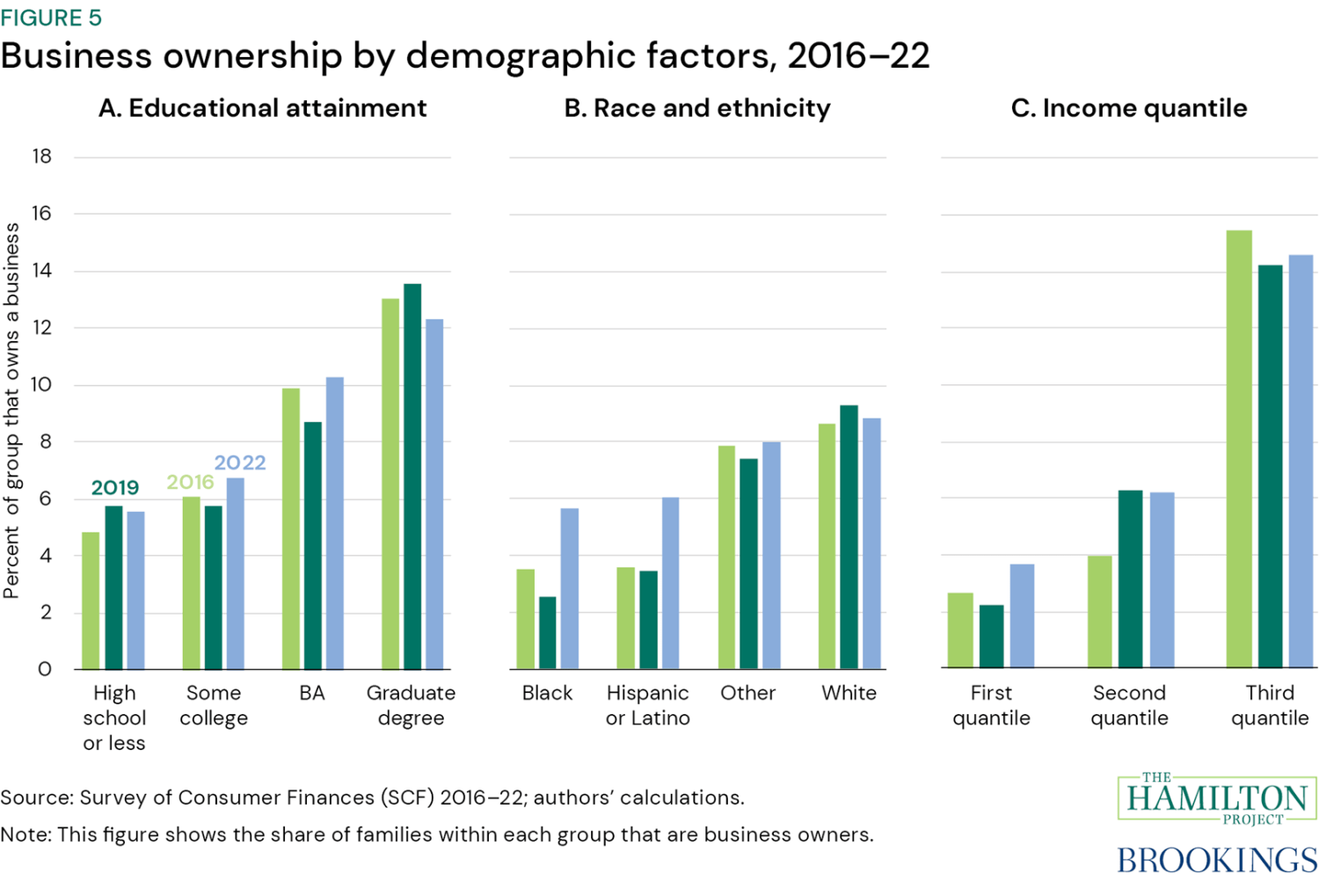
Changes in 2022 relative to previous years were not uniform. In particular, we see a significant increase in the share of families owning businesses for Black and Hispanic or Latino families. We don’t see a similar increase for white families in this period. As a result, the gap between business ownership among white families and Black and Hispanic or Latino families shrunk in 2022. Likewise, we see an increase in ownership for those in the first quantile but don’t see a similar increase for those in the second and third quantiles.
What share of each group gained ownership over a business in the prior three years?
Figure 6 shows the share of each group who gained ownership over the past three years prior to and including each survey year. The share of families that gained business ownership in the three years through 2022 jumped significantly for Black and Hispanic or Latino families (panel B) relative to white families. Figure 7 consolidates the information in figures 5 and 6, showing ownership gained in the three years through each survey (darker portion of the bars) as a share of each group’s total ownership share (entire bar including darker and lighter portions).
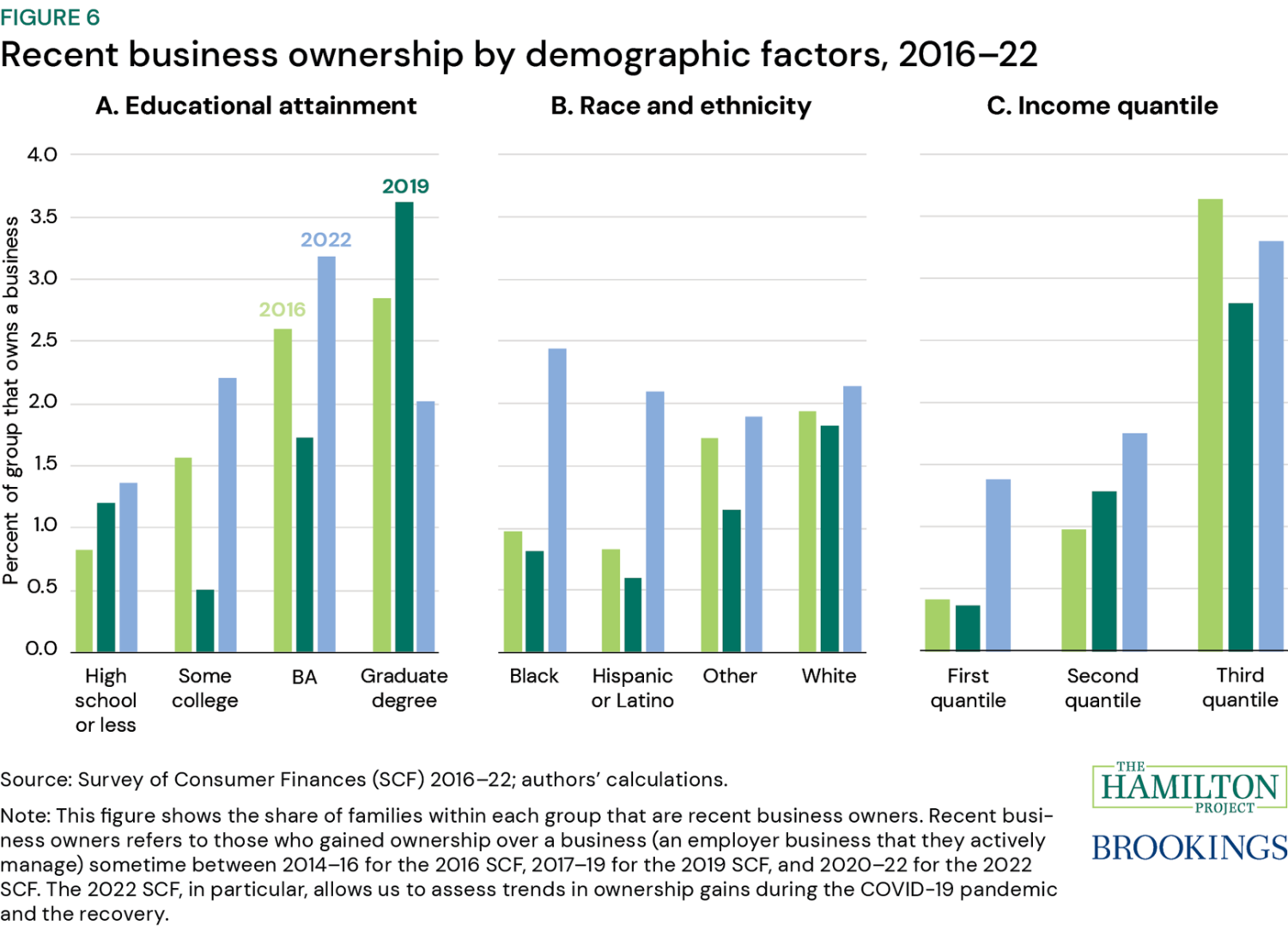
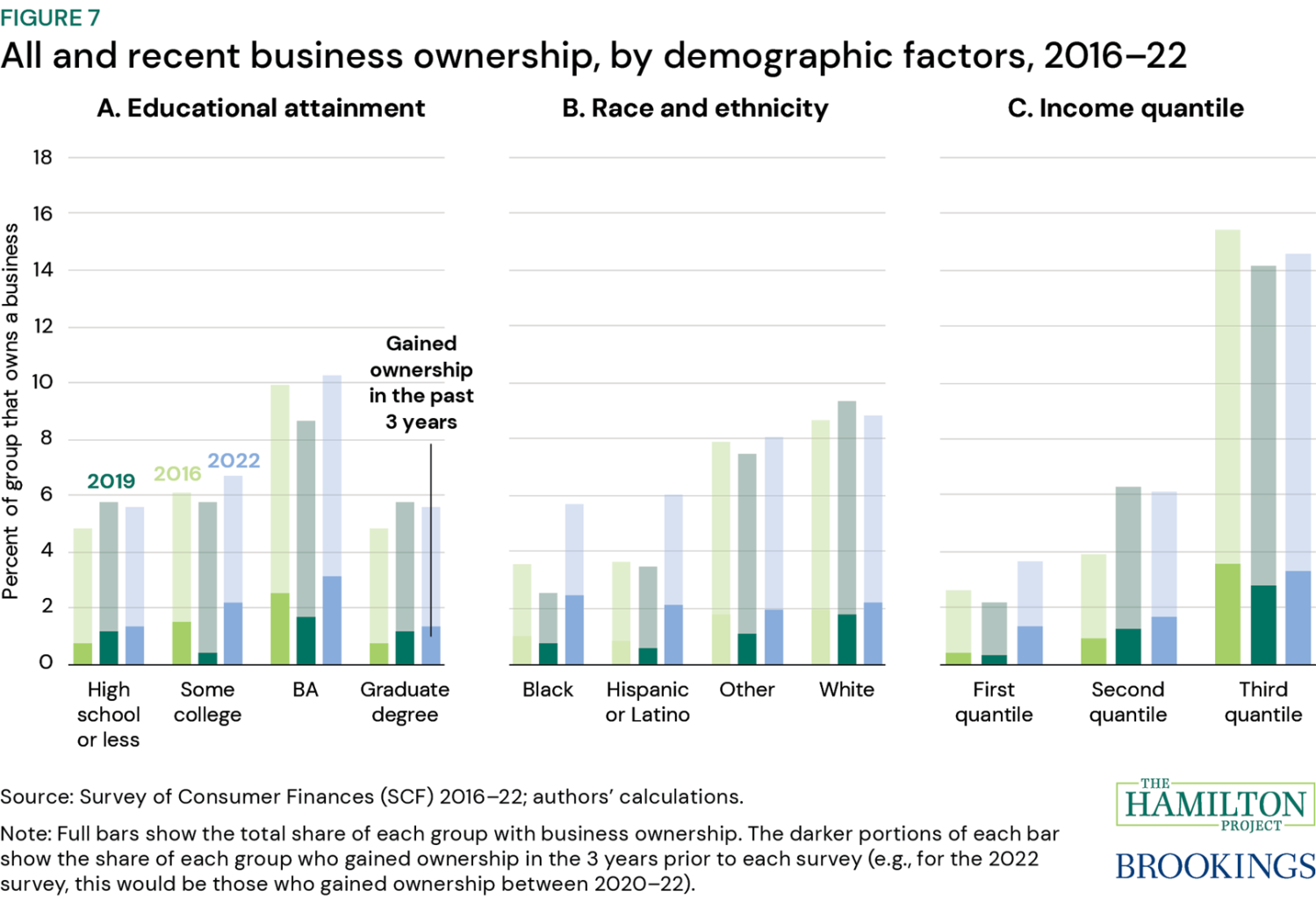
That is to say, the demographic trend in new business ownership between 2019 and 2022 helped to close the racial and ethnic gaps in ownership, even as significant gaps continued to persist. Put differently, a much larger share of total business ownership for Black and Hispanic or Latino families was due to recent ownership (i.e., ownership gained in the last three years), relative to white families. Similarly, a larger share of total business ownership for the first quantile of income was from the last three years relative to the second and third quantiles.
As noted above, these estimates for recent business ownership are less precise than those for all business ownership because the sample size is significantly smaller. However, they indicate that, within the past few years, groups that have historically had relatively low levels of business ownership are experiencing rising levels of entrepreneurship—and that, as a result, ownership gaps are shrinking. Our findings align with other research on the demographic makeup of businesses in 2019 and 2020 and suggest that there might be changing patterns during the COVID-19 pandemic and recovery (Fazio et al. 2021, Lee 2023).
To what degree did business ownership—in particular recent business ownership—contribute to wealth gains across groups?
While the demographic distribution of business ownership is worthy of study on its own, a primary consideration is the degree to which changes in ownership add to net worth and reduce wealth inequality. Figure 8 shows the average value of employer businesses among those who owned such businesses by educational attainment (panel A), race and ethnicity (panel B), and income quantile (panel C). Figure 9 shows the median value of these businesses among those who owned businesses for the same groups. (Both figures show inflation-adjusted value in 2022 dollars.)
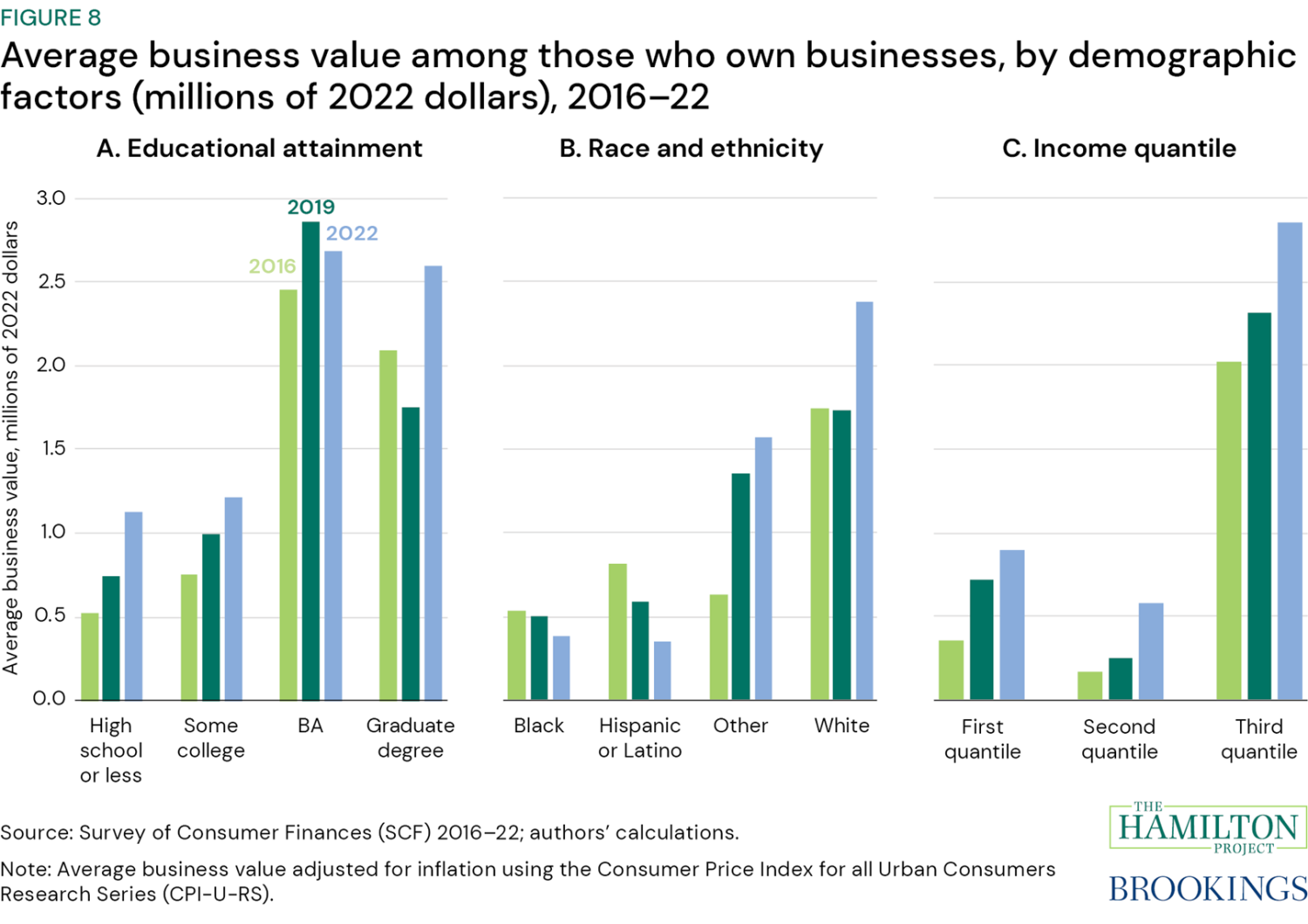
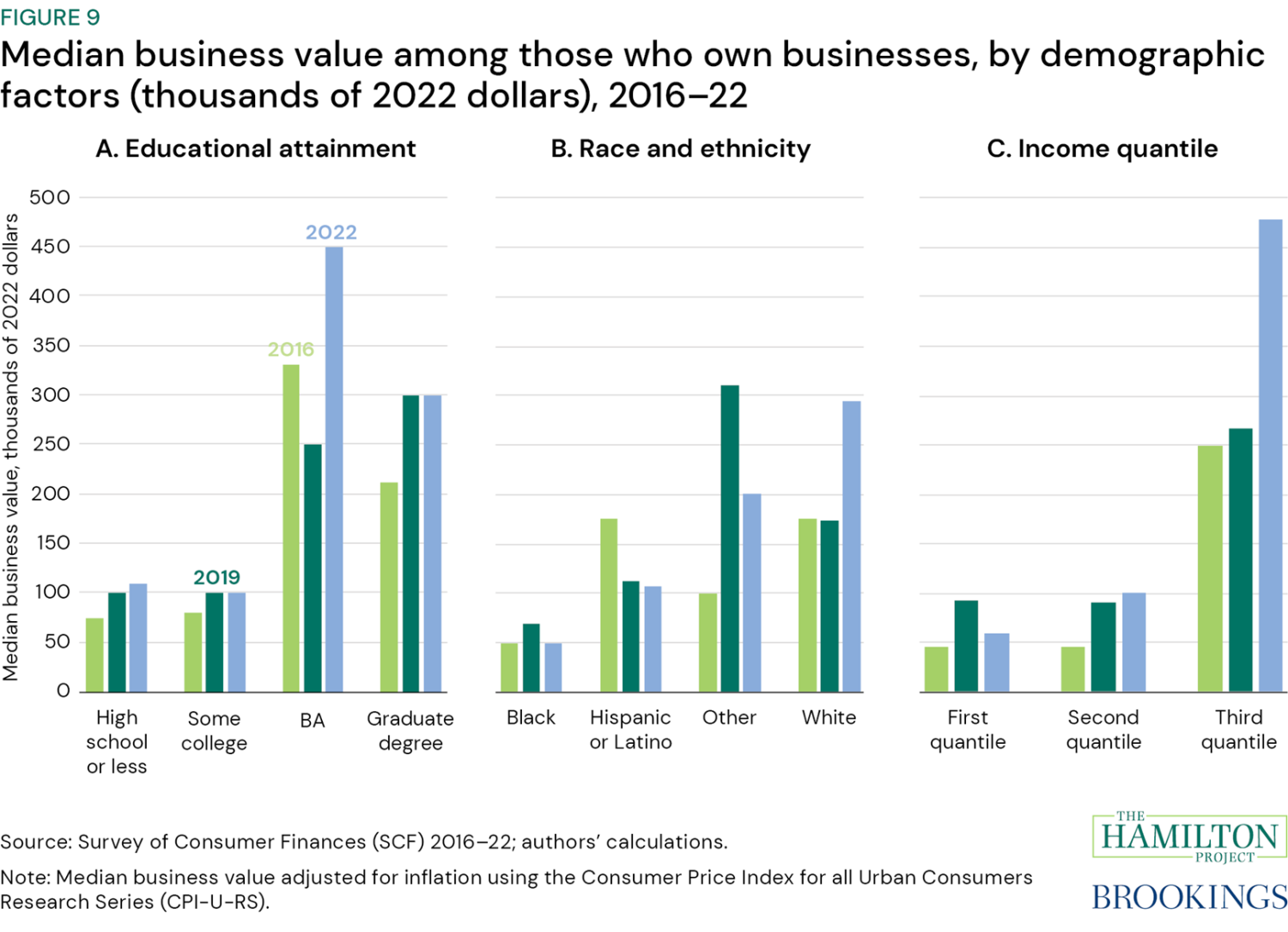
While the share of Black families who owned business equity rose substantially in 2022 (figures 5–7), the average (figure 8; panel B) or median (figure 9; panel B) value of those businesses (in inflation-adjusted 2022 dollars) remained low. Several factors likely dampened the relative value of businesses owned by Black families. A greater share of businesses owned by Black families were started or bought in recent years (figure 7), and as we show below (figure 12), such recently created businesses are typically of lower value than older businesses. Conversely, a smaller share of businesses owned by white families were recently started or bought (figure 7). In addition, research on business entry during the COVID-19 pandemic suggests that firm sizes shrunk during the pandemic due to both existing firms shrinking as well as the entry of new firms, which are generally smaller (Decker and Haltiwanger 2022).
How do gains in business ownership influence wealth building across groups?
The role that business ownership plays in overall net worth differs across racial and ethnic groups. While median wealth across groups rose from 2019 to 2022, the wealth gap between racial and ethnic groups has increased as well (Perry et al. 2024). We investigate how increased levels of business ownership contributed to changes in overall net worth in this period (figure 10). This is useful in understanding the role that business equity played in net worth gains during the pandemic and recovery.
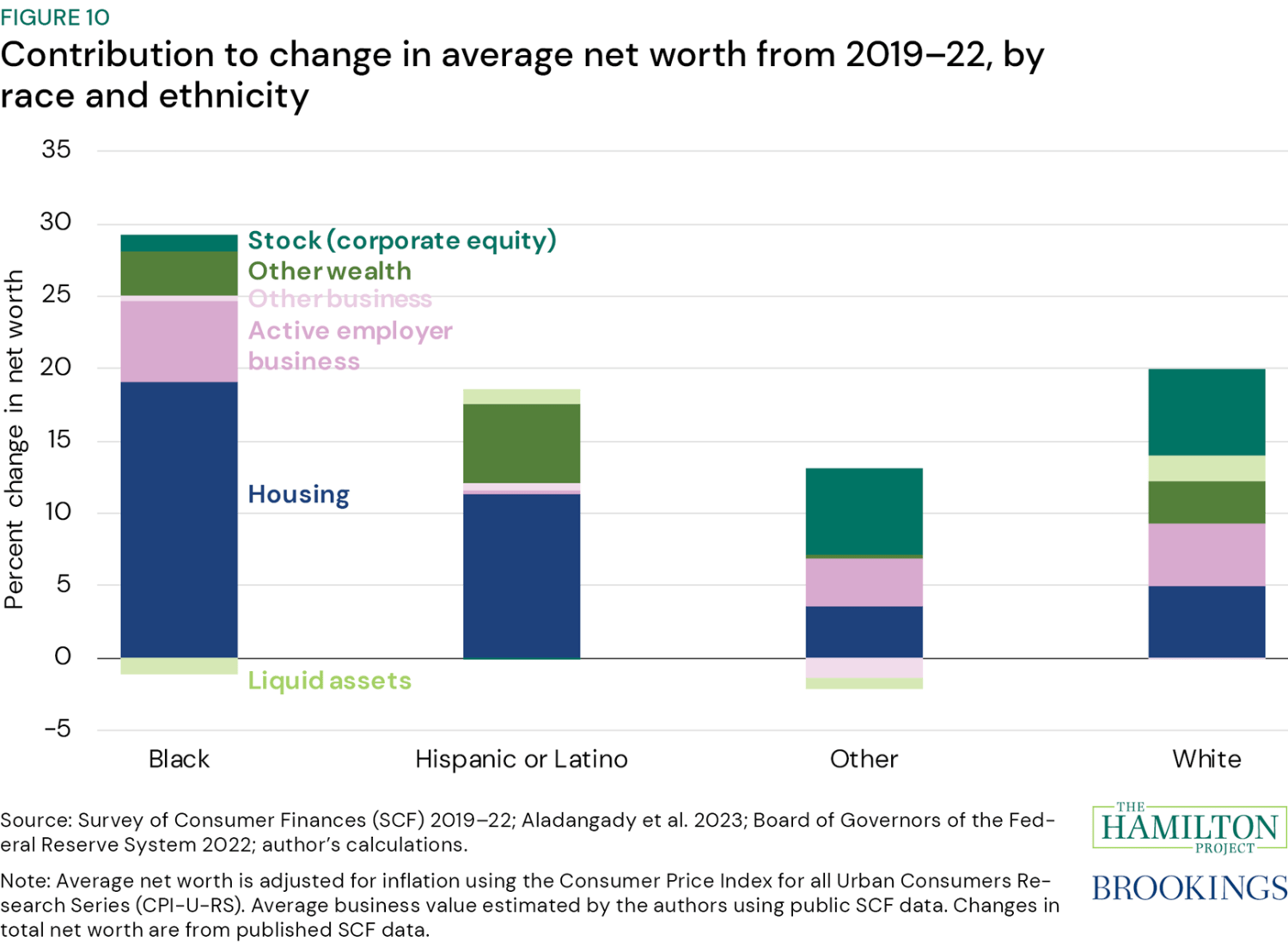
On average, from 2019 to 2022, total net worth among Black families as measured by the SCF had the largest percentage increase across racial and ethnic groups. Most of this increase was due to an increase in net housing wealth. Nonetheless, the percentage increase in wealth from employer-business ownership was substantial. Data in SCF suggest that increase occurred not because the value of businesses owned by Black families increased from 2019 to 2022 (indeed, this is not the case, as shown in figures 8–9 above). Rather, the data suggest that this increase occurred because many Black families gained ownership over this period and thus went from having no net worth from ownership in employer businesses to having positive business equity (figures 5–7 above).
However, gaps in total net worth and in net worth from business equity continue to persist (Aladangady et al. 2023; Perry et al. 2024). Figure 11 shows average equity in employer businesses as a share of average total net worth, by race and ethnicity. Business equity as a share of total net worth is consistently highest among white families. Thus, not only are businesses owned by Black and Hispanic or Latino families worth less, on average (figure 8), but these businesses also contribute less to overall wealth than for white families (figure 11).
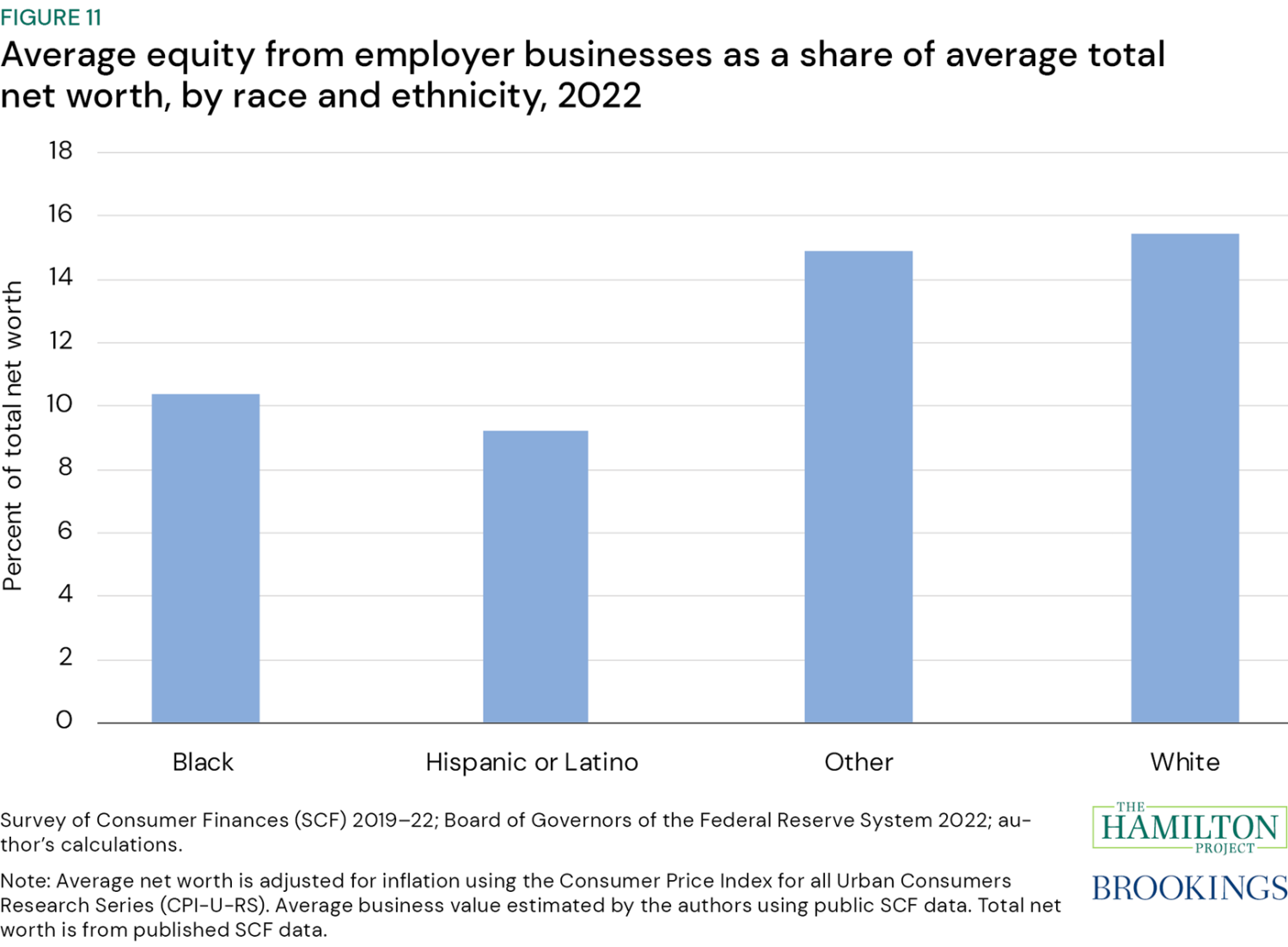
It is important to note that changes in wealth from gains in business ownership are likely not immediate. Thus, recent increases in business ownership among Black and Hispanic or Latino families may contribute to greater wealth accumulation over time. Figure 12 compares the average (panel A) and median (panel B) value of all businesses (in pink) with those for which ownership was gained in the past three years prior to a given survey (in blue). Businesses recently created or purchased are consistently much smaller in value than the whole set of employer businesses. Businesses that are able to survive often grow in value over time.
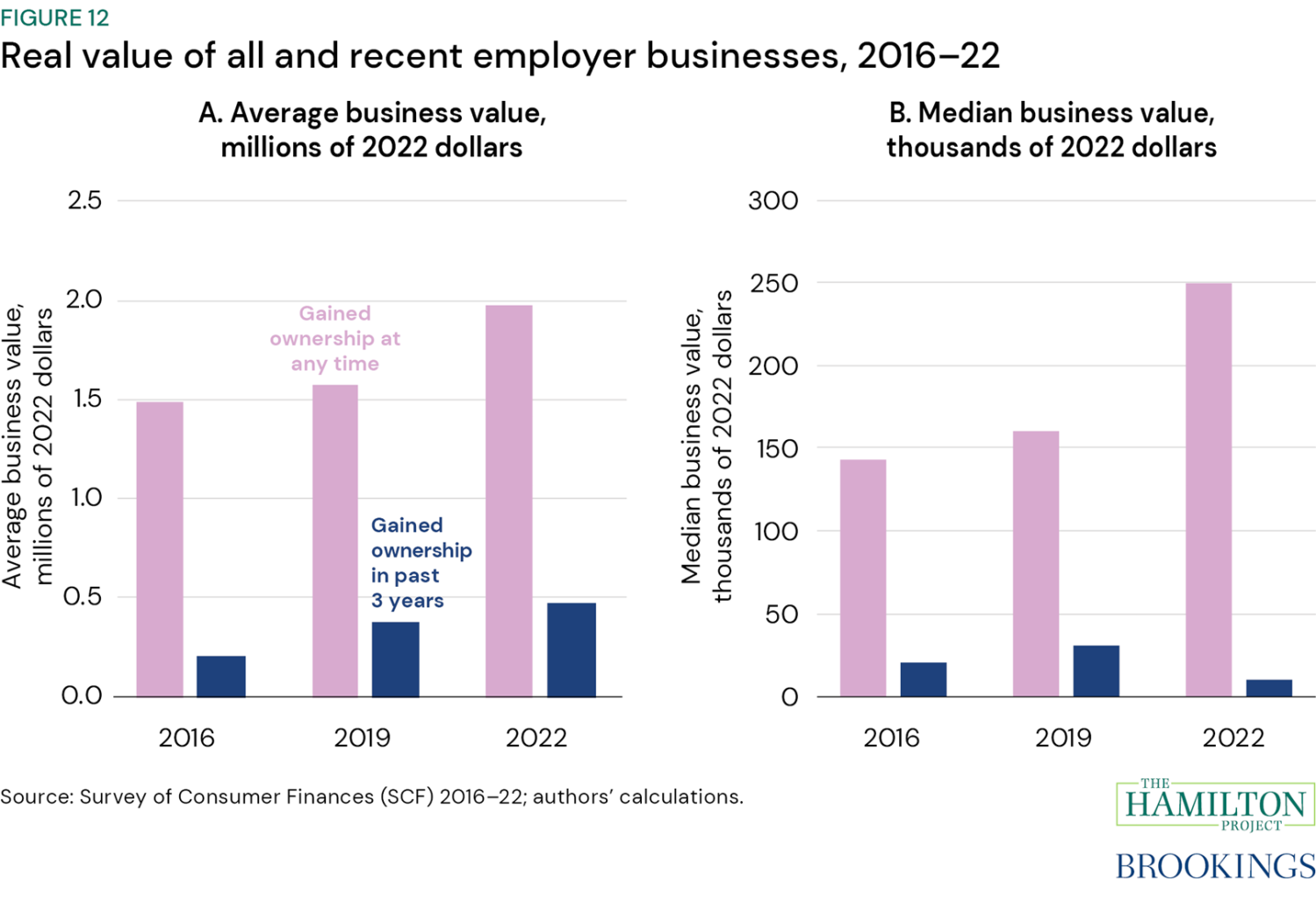
Conclusion
Policymakers can take actions to support the positive economic developments described here. For example, greater business ownership among Black and Hispanic or Latino families suggests a more dynamic U.S. economy with greater opportunities for wealth creation and greater productivity (Klein 2021). Increased business ownership by underrepresented groups has community-wide impacts including increased employment opportunities (Bates et al. 2021). As mentioned above, new businesses tend to have high failure rates, with a small share of businesses experiencing high levels of growth and job creation (Haltiwanger, Jarmin, and Miranda 2013; Decker et al. 2014). If economic conditions and the policy environment allow these recently created businesses to survive and grow, the increase in business equity among Black, Hispanic, and Latino families will help to close wealth gaps. In addition, such developments mean a more diverse set of assets for those families, which improves resiliency in the face of negative economic shocks, such as a reduction in house prices.
Researchers and policymakers should continue to follow these developments and work to better understand them. What types of businesses comprise the recently created businesses among Black, Hispanic, and Latino families? How fast are these businesses growing? What sectors are they in and who are they employing? Do constraints facing these businesses suggest areas for policy intervention?
The Hamilton Project has released multiple policy proposals to foster greater opportunities for business creation. In particular, policymakers should further the progress made by the Biden Administration to limit non-compete contracts and occupational licensing requirements (White House 2021; Krueger and Posner 2018; Marx and Nunn 2018; Nunn 2021). In addition, policies could be implemented to increase access to capital when people have great business ideas but face credit constraints (Barr 2015).
The last few years have been marked by an extraordinary increase in business formation. Policymakers should seize the opportunities that this provides.
References
Aladangady, Aditya, Andrew C. Chang, and Jacob Krimmel. 2023. “Greater Wealth, Greater Uncertainty: Changes in Racial Inequality in the Survey of Consumer Finances.” Board of Governors of the Federal Reserve System, Washington, DC.
Bates, Timothy, Joseph Farhat, and Colleen Casey. 2022. “The Economic Development Potential of Minority-Owned Businesses.” Economic Development Quarterly, 36 (1): 43-56.
Barr, Michael S. 2015. “Minority and Women Entrepreneurs: Building Capital, Networks, and Skills.” The Hamilton Project, Brookings Institution, Washington, DC.
Board of Governors of the Federal Reserve System. 2022. “Estimates inflation-adjusted to 2022 dollars.” Available at: https://view.officeapps.live.com/op/view.aspx?src=https%3A%2F%2Fwww.federalreserve.gov%2Feconres%2Ffiles%2Fscf2022_tables_public_real_historical.xlsx&wdOrigin=BROWSELINK.
Board of Governors of the Federal Reserve System. 2016—2022. “Survey of Consumer Finances. Board of Governors of the Federal Reserve System, Washington, DC.
Decker, Ryan and John Haltiwanger. 2022. “Business entry and exit in the COVID-19 pandemic: A preliminary look at official data.” Board of Governors of the Federal Reserve System, Washington, DC.
Decker, Ryan and John Haltiwanger. 2023. “Surging Business Formation in the Pandemic: Causes and Consequences?” Brookings Papers on Economic Activity Conference Draft. Brookings Papers on Economic Activity Fall 2023. The Brookings Institution, Washington, DC.
Decker, Ryan, John Haltiwanger, Ron Jarmin and Javier Miranda. 2014. “The Role of Entrepreneurship in US Job Creation and Economic Dynamism.” Journal of Economic Perspectives (2014) 28 (3): 3-24.
Dinlersoz, Emin, Timothy Dunne, John Haltiwanger, and Veronika Penciakova. 2023. “Local Origins of Business Formation.” United States Census Bureau Center for Economic Studies Working Paper 23-24. United States Census Bureau, Suitland, MD.
Fazio, Catherine E., Jorge Guzman, Yupeng Liu and Scott Stern. 2021. “How Is Covid Changing The Geography Of Entrepreneurship? Evidence From The Startup Cartography Project.” NBER Working Paper 28787. National Bureau of Economic Research, Cambridge, MA.
Haltiwanger, John C. 2021. “Entrepreneurship During the COVID-19 Pandemic: Evidence From The Business Formation Statistics.” NBER Working Paper 28912. National Bureau of Economic Research, Cambridge, MA.
Haltiwanger, John C., Ron S. Jarmin and Javier Miranda. 2013. “Who Creates Jobs? Small vs. Large vs. Young.” The Review of Economics and Statistics (2013) 95 (2): 347–361.
Klein, Joyce. 2021. “Building Wealth Inclusively Through Business Ownership.” Aspen Institute, Washington, DC.
Krueger, Alan B. and Eric A. Posner. “A Proposal for Protecting Low-Income Workers from Monopsony and Collusion.” The Hamilton Project, Brookings Institution, Washington, DC.
Lee, Lynda. 2023. “Minority Business Ownership Differs by Sector.” United States Census Bureau, Suitland, MD.
Marx, Matt and Ryan Nunn. 2018. “The Chilling Effect of Non-Compete Agreements.” The Hamilton Project, Brookings Institution, Washington, DC.
Nunn, Ryan. 2021. “Removing Policy Obstacles to Competitive Labor Markets.” The Hamilton Project, Brookings Institution, Washington, DC.
Perry, Andre M., Hannah Stephens and Manann Donoghoe. 2024. “Black wealth is increasing, but so is the racial wealth gap.” The Brookings Institution, Washington, DC.
United States Census Bureau. 2024a. “Business Formation Statistics Methodology.” United States Census Bureau, Suitland, MD.
United States Census Bureau. 2024b. “Business Formation Statistics.” United States Census Bureau, Suitland, MD.
United States Census Bureau. 2019—2021. “Annual Business Survey.” United States Census Bureau, Suitland, MD.
White House. 2021. “Fact Sheet: Executive Order on Promoting Competition in the American Economy.” The White House, Washington, DC.


